Harbans Lal, Ph.D., D. Litt. (Hon)
My last visit to Pakistan was in February 2006, when I led a delegation of Sikh scholars on a pilgrimage tour of our holy shrines. I also co-organized a conference there as Executive Vice President of the Sri Nanakana Sahib Foundation. The late Sardar Ganga Singh Dhillon was the Chairman of the Foundation.
Sikhs have special affinity to the soil of Pakistan as their religion originated in that region of South East Asia. It ripened there and eventually Sikhs established a kingdom that extended from Afghanistan to Central India.
Although India was partitioned along religious lines, leaders of both countries assured the respective minorities of full rights and privileges. For reference, I often quote Mr. Patrick French who highlighted Pakistan’s founding President Quaid-i-Azam’s political vision from his address to the Constituent Assembly of Pakistan on August 11, 1947.
While addressing the Constituent Assembly of Pakistan, Quaid-i-Azam Jinnah said: “You may belong to any religion or caste or creed – that has nothing to do with the business of the state. We are starting with the fundamental principle that we are all equal citizens of one state. Now I think we should keep that in front of us as our ideal and you will find that in the course of time, Hindus will cease to be Hindus and Muslims will cease to be Muslims, not in the religious sense because that is the personal faith of each individual, but in the political sense as citizens of the state.”
I believed that the people of Pakistan would follow the advice of their founder and that our conference would be seen positively, and we were indeed received with open arms throughout our pilgrimage.
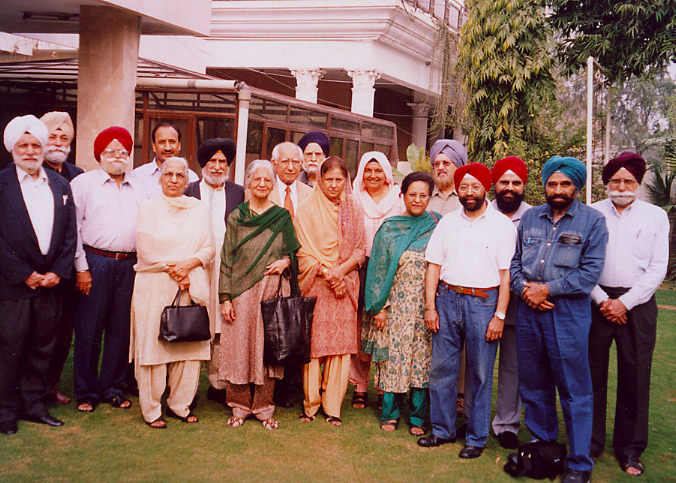 Some of the members of the Sikh delegation after a breakfast reception at the residence of Col. Hamid Ali Khan, a business magnet of Lahore, Pakistan.
Some of the members of the Sikh delegation after a breakfast reception at the residence of Col. Hamid Ali Khan, a business magnet of Lahore, Pakistan.
Interfaith Conference
Our delegation was invited by the leadership of Pakistan to hold an interfaith symposium focused on Guru Nanak’s message of peace and unity on February 17-19, 2006. In response, we called upon several Muslim scholars and national leaders from Pakistan to also enthusiastically participate. Indeed, the symposium hall was filled to brim. The conference dates included a pilgrimage to Sri Nanakana Sahib and Gurdwara Kartarpur Sahib. Copy of invitation is reproduced below for archival purpose.
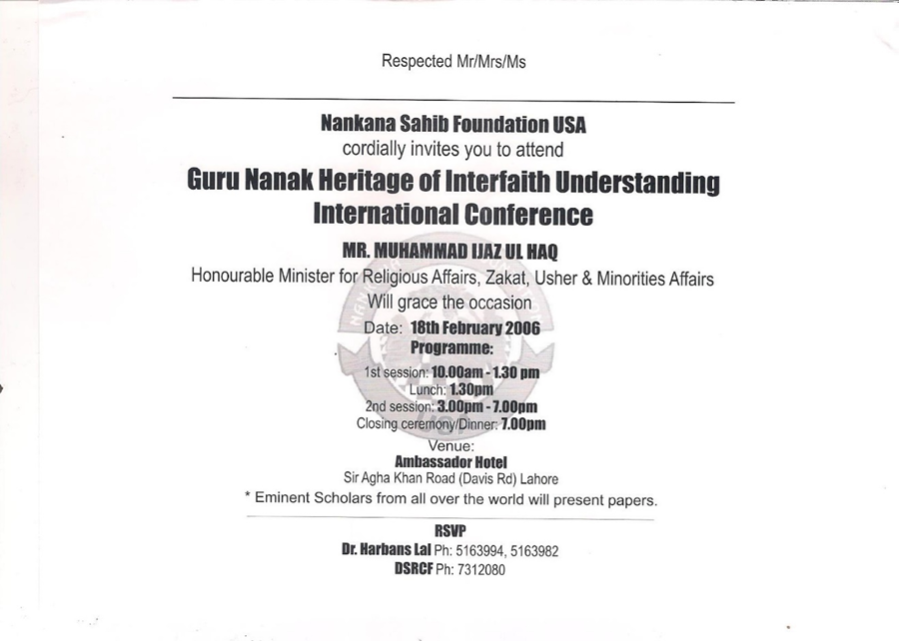
The conference was co-organized by the Nanakana Foundation and Dyal Singh Trust and Library, as well as the Dyal Singh Research & Cultural Forum of Lahore, with cooperation from the Pakistan Sikh Gurdwara Parbandhak Committee (PSGPC), Academy of Guru Granth Studies, and Sikh Awareness Foundation.
Two dozen speakers from the Middle East, India, Australia, Canada and the USA participated along with Islamic leaders from Pakistan. They represented many diverse areas of expertise and leadership in the faith communities. There were educators, civic and community leaders, international organizations, media representatives, members of PSGPC and officials of the Punjab and the National Governments.
The conference began with prayers from the Holy Quran and Sri Guru Granth Sahib. The program included presentations, lectures, panel discussions, devotional music and singing. Networking to visit and connect with one another was promoted through social interaction over tea and lunch breaks and through a display of paintings and art works. The underlying spirit that guided the meeting was education and information sharing about the faiths and cultures of the Muslim and the Sikh communities in Pakistan.
In my inaugural address I spoke of the challenges of the global village. I emphasized that “Cultures and religions live very closely together today, and the human race should use interfaith dialogue as an approach to coping with the unprecedented challenges of the new world”.
I spoke at length on the new Sikh history that began with the creation of Pakistan. I outlined the contributions of the Sri Nanakana Sahib Foundation in facilitating regular visits of the world Sikh community for pilgrimages to the Sikh shrines in Pakistan. The Government of Pakistan and the Shromani Gurdwara Parbandhak Committee were acknowledged for their efforts in making it happen.
The Harvard educated Director of the Dyal Singh Research and Cultural Forum, Dr. Zafar Cheema, conducted the conference and said that Muslim intelligentsia chose to support the conference because of the vital role the followers of Guru Nanak and those of Islam could play in the promotion of world peace.
Islamic contribution to inter faith understanding was the topic of a forceful presidential address by Justice Tasneem Ali Chowhan, UN judge at the International Criminal Tribunal The Hague.
Honorable Syed Afzal Haider, Former Law Minister of Pakistan, condemned the media that played upon the religious sensitivities of various faith communities to further their political agenda.
Former Vice Chancellor of Guru Nanak Dev University, India, Dr. Harbhajan Singh Soch presiding over the academic session, said that the best way to bring peace today was to promote frank deliberations on the values held sacred by all faiths.
Lt. Gen (R) Zulfiqar Ali Khan, Chairman Evacuee Property Trust Board, narrated how the number of Sikh pilgrims from all over the world was snowballing year after year. He thanked the speakers, delegates and the organizers of the conference. He hoped for more conferences that promoted Muslim Sikh Itehad.
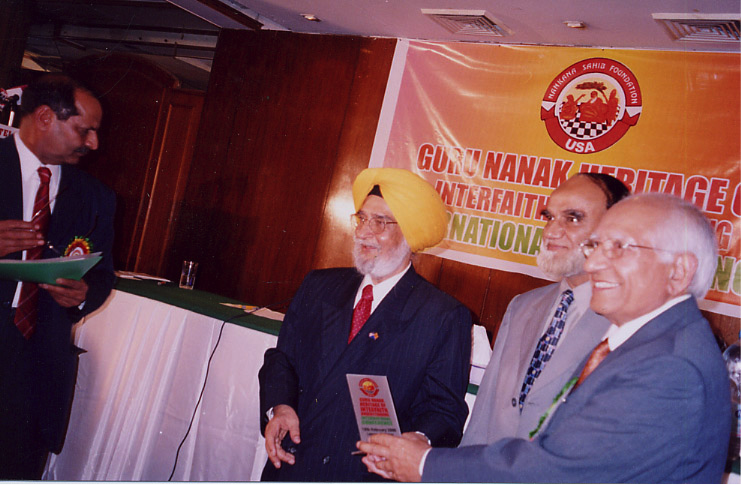
Executive Vice President of Sri Nanakana Sahib Foundation Bhai Harbans Lal (right) being honored by Lt. Gen (R) Zulfiqar Ali Khan Chairman Evacuee Property Trust Board (center), Sardar Ganga Singh the Foundation President, and Director of Dyal Singh Research and Cultural Forum Dr. Zafar Cheema (left).
Others who spoke and participated in discussions and comments included; Bibi Jessiee Kaur Singh, President of Multi-faith Association of South Australia; Bibi Kanwal Kaur Hundal, President Pakistan Sikh Women Association, Choudhary Hamid Ali Khan Resident Director Sri Nanakan Sahib Foundation, Dr. Devinder Singh Chahal President Institute for Understanding Sikhism and Editor-in-Chief Understanding Sikhism – The Research Journal, Dr. Harbhajan Singh Soch Former Vice Chancellor Guru Nanak Dev University, Dr. K.L. Sheshagiri Rao Editor of Encyclopedia of Hinduism, Dr. Kuldip Singh Hanjan President, Sikh Center of Southern California, Dr. Nirmal Singh Convener Sikh Forum of Central Pennsylvania, late Dr. Suarn Singh Acting President Pakistan Gurdwara Parbandak Committee, Dr. Tejinder Singh leader of Sikh Congregation in Kuwait, Dr. Ujagar Singh Bawa of The Washington Sikh Center/The Sikh Youth Forum, Janab Iqbal Quiser President Punjabi Literary Society of Pakistan, Janab Izhar Ul Hassan Additional Secretary (Shrines) Pakistan, Journalist Akram Hameedi of Dawn, Journalist Parminder Singh Soch of Sikh Community at Rochester New York and North Carolina, Lt. Gen (R) Zulfiqar Ali Khan Chairman Evacuee Trust Property Board, Mr. Haroon Adeem well-known Punjabi Poet of Lahore, Padma Bhushan Captain M.S. Kohli, I.N. (Retd), AVSM, FRGS, Order of the Khalsa, Chairman Himalayan Trust, Professor Shaista Nuzhat Director of The Punjab Institute of Language, Art and Culture; Sardar Ganga Singh Dhillon President Sri Nanakana Sahib Foundation, Sardar Harbhajan Singh of World Bank and Secretary National Gurdwara at Washington DC, Sardar Gajinder Singh of the Sikh Foundation Maryland, Sardar Kartar Singh Bal, Board Member North Carolina Sikh Society, Sardar Manmohan Singh Virk, Descendent of Jathedar Bhai Kartar Singh Jhabbar of Gurdwara Reform Movement; Sardar Mastan Singh, Ex-President Pakistan Sikh Gurdwara Parbhandak Committee; Sardar Mohinder Singh, Author and Journalist of New Delhi, and Miss Khan, Grand daughter of Sir Sikandar Hayat Khan.
In a resolution passed unanimously, the groups condemned the blasphemous cartoons of Prophet Mohammed in Danish and other European papers, emphasizing that the prophets of all religions should be esteemed by people of each faith. In fact, the United Nations’ charter of human rights does not permit blasphemous behaviors.
Press Conferences
Meeting with press at the Interfaith Conference, Sardar Ganga Singh said that many problems of conflict between India and Pakistan might be resolved through interfaith dialogue. Sardar Ganga Singh, who was the main force behind the safekeeping of the Sikh shrines in Pakistan during the past thirty years, was interviewed by the media, and his interviews were widely aired. I pointed out to the press that if media coverage was any indication of success, the conference was a great triumph towards promoting interfaith engagement.
After the conference event I was again invited to hold a press conference at the famous Lahore Press Club. Over two dozen newspapers and two national TV stations covered or commented on this conference. I was pleased to speak to the press in Urdu. Earlier I was invited as luncheon speaker at the Lahore Chamber of Commerce and Industry. The Lahore Chamber of Commerce and Industry was established by the businessmen and industrialists of Northern India in 1923 under the name of “Northern India Chamber of Commerce and Industry”. In 1947, its name was changed to “West Pakistan Chamber of Commerce and Industry”. In 1960, the present name, “The Lahore Chamber of Commerce and Industry”, was adopted. Today, the chamber is the first ISO-Certified Chamber of Pakistan.
I expressed my satisfaction on the observation that since the time of our first announcement of the interfaith conference, phrases such as Interfaith Understanding for Harmony began to find a place in the speeches of the national leadership of Pakistan. Our conference in Lahore had a positive impact on the political tone in Pakistan. I emphasized that religious intolerance was against the teachings of both Sikhism and Islam. Guru Nanak’s heritage may help provide a revival link between India and Pakistan and between Pakistan and Rest of the World.
I told the press that it was significant to hold the International Interfaith Conference in a country which was prematurely maligned by its adversaries as the home of religious fanatics. The very history and architecture of Lahore reminded me that Lahore was a city of gates which welcomed and accepted many cultures, arts and religious thoughts throughout ages. Similarly to celebrate Guru Nanak Heritage of Interfaith Understanding and Engagement was meant to pay a tribute to the prophet who was born on that land, and who traveled around the world visiting the holy places of all religions in order to promote dialogues of understanding and peace.
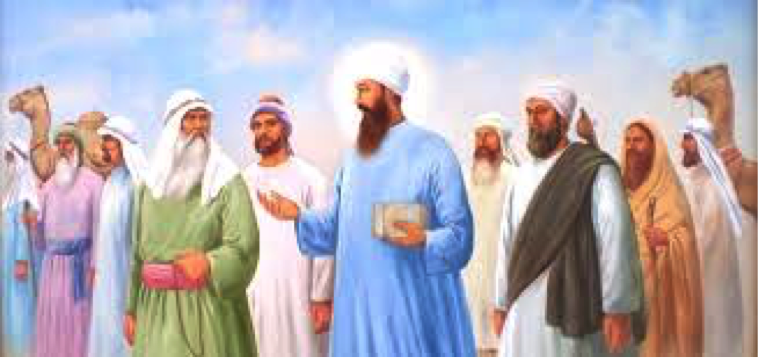
I recounted the special significance of Lahore for us Sikhs. The kingdom of Maharaja Ranjit Singh had special affinity with the city. Our fifth guru was martyred in this city four centuries earlier. Beloved to Sikhs and Muslims alike, Pir Hazrat Mian Mir lived in this city. The Pir was so beloved to Guru Arjan that the Guru walked from Amritsar to Lahore, [bare] feet, to escort the Hazrat to Amritsar to lay the foundation stone of Sikhs’ holy shrine, Sri Harmander Sahib aka the Golden Temple.
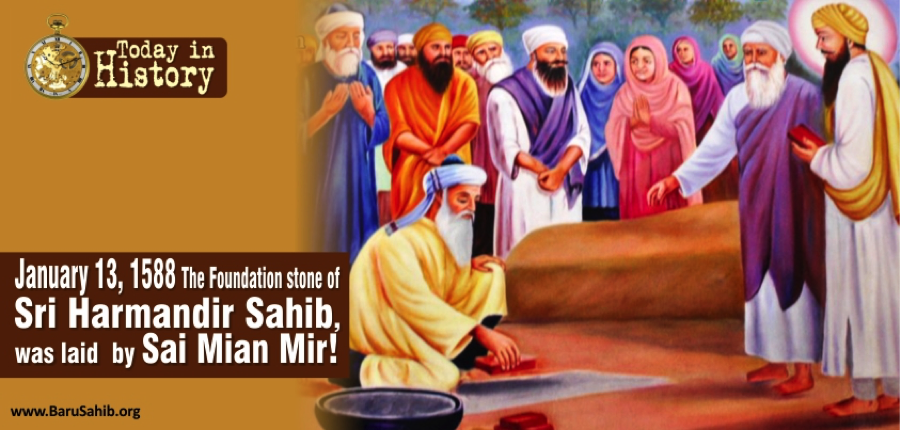
Further, the city of Amritsar was built by our 4th guru, Guru Ram Das, on a land portion of which was gifted by a Muslim King, Akbar. I did not forget to acknowledge that Guru Ram Das was born in Lahore. His home was renovated into a modern Sikh shrine to facilitate the continuous flow of the faithfuls.
At the end, I discerned the lack of teaching curriculum on Sikhism in Pakistani schools. I appealed to the educational administration in Pakistan to consider amending that neglect.
President of the Lahore Chamber of Commerce, who opened the press conference, said his Chamber chose to sponsor the event because of the “vital role” that religions had in the promotion of peace. He emphasized that religions were at the heart of Pakistani culture and society. He thanked me for the information and requested that I consider visiting Pakistan periodically.
The Nanakana Sahib Martyrs Day
The International Symposium coincided with the date of February 20, when 139 nonviolent Sikh volunteers gave their lives to liberate Gurdwara Janam Asthan Sri Nanakana Sahib from corrupt managers and clerics in 1921. This day was traditionally celebrated every year before the partition, but had not been commemorated for the past 59 years. Our objective was to inspire the Sikh Nation to resume memorializing the event in order to keep Sikh shrines out of the hands of selfish clerics. Thus the delegates from the International Symposium in Lahore were transported to Sri Nanakana Sahib for the Nanakan Sahib Martyrdom Day Conference.
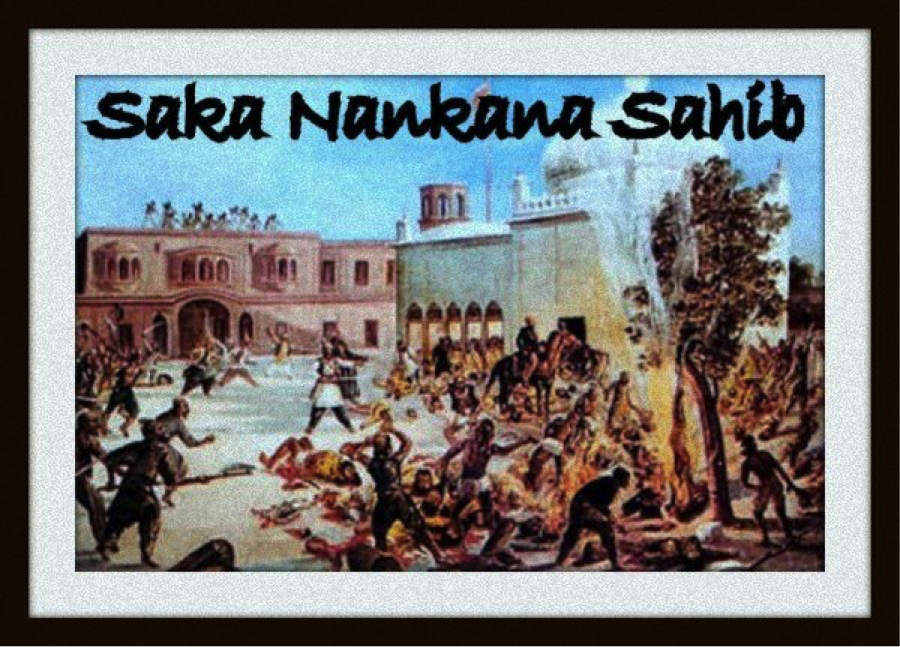
The commemoration was held where the much talked about Golden palanquin Palki was installed in a glass chamber by the Dehli Gurdwara Management Committee. The Guru Granth Sahib was installed in this Palki. A volume of Sri Guru Granth Sahib was earlier carried in the gold palanquin from New Delhi to Nankana Sahib in Pakistan, covering more than 700 km. This was the longest religious procession after the Partition.
After Ardas, Dr. Kuldip Singh Hanjan of Los Angeles recited kirtan. A Sikh scholar from Lahore, Iqbal Qaiser, recited a poem as homage to Guru Nanak. I spoke on the antecedents that led to the martyrdom at that sight. In a resolution, Sikh organizations all over the world were requested to commemorate this day every year to remind us of the sacrifices needed to protect and promote our religious shrines.
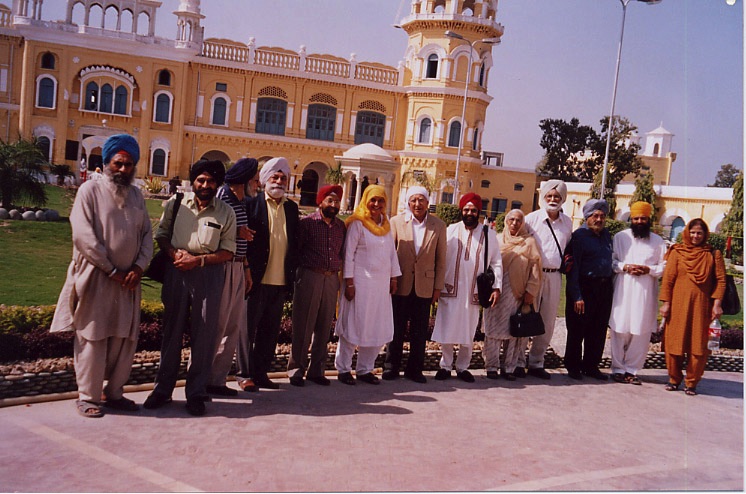
International Sikh delegation outside Guru Nanak’s birth place, Sri Nanakana Sahib, Pakistan.
Visit to Kartarpur Gurdwara
A visit was arranged for the delegates to pay their obeisance at Gurdwara Kartarpur on the last day of the Symposium. After a breakfast at the residence of Chaudhary Hamid Ali Khan, Chief Coordinator, Reception and Arrangement Committee, the delegates were taken to Guru Nanak’s shrine of Kartarpur. There we held a congregation to pray for world peace. Guru Nanak (1469-1539) spent the last 18 years of his life in this town, and he founded a community of spiritual householders who would spread peace and harmony. It is there that he held dialogues with many community leaders on his teachings. History tells us that it is here that Guru Nanak promulgated his doctrine of Naam, Daan, and Ishnaan that succinctly translated as Mind of Enlightened Consciousness, Culture of Altruism and Ethics of Goodness.
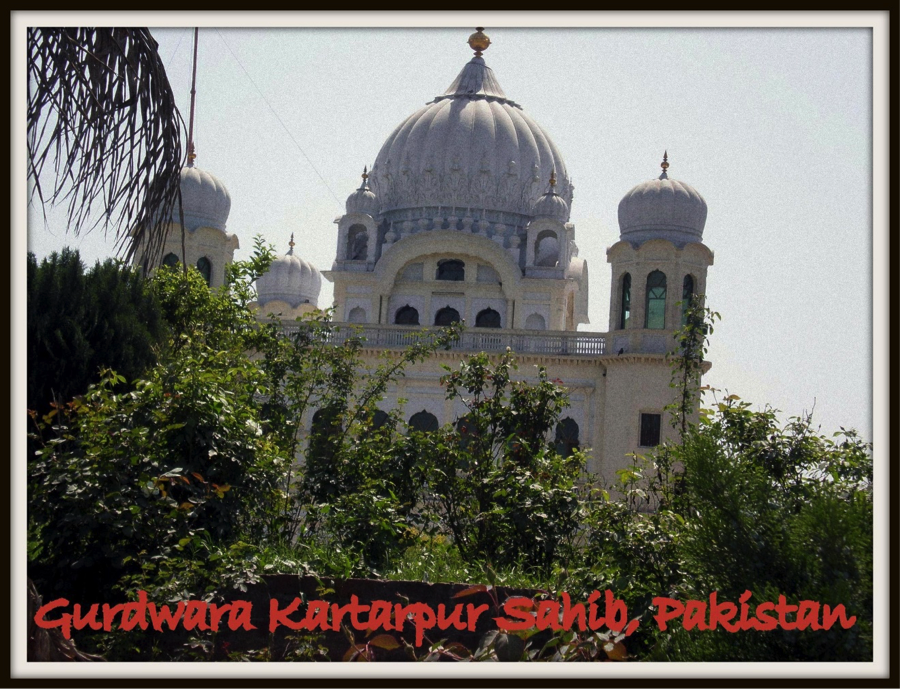
We paid our homage to his burial mausoleum built by Muslims and his cremation ground where Samadhi was built by the Hindus, both laying side by side, bearing witness to Guru Nanak’s teachings for the whole humanity irrespective of religion, ethnicity, caste, race, class status, etc. Dr Kuldip Singh Hanjan of California recited a hymn from the Guru Granth and Mr Iqbal Qaiser recited a poem written by Dr Teja Singh of Edmonton, Canada who could not participate in the conference due to ill health.
Sardar Manjit Singh, who was continuing the Gurdwara renovation showed us around. Iqbal Qaiser, the author of Sikh Shrines in Pakistan recounted the earlier condition of the shrine. Until a dam was built, the holy shrine was in ruins because of the flood waters from the Ravi River often flowing on the ground floor of the Gurdwara. We recognized the donation from Canadian Sikhs to repair the Gurdwara once the Evacuee Property Board completed the necessary dam on insistence of the Nanakana Foundation. Sikh pilgrims have since continued rebuilding the shrine to this date.
Through the contacts built by Harbhajan Singh, who was formally a World Bank official, we visited the World Bank at Islamabad to promote a proposal of building a corridor over the river Ravi to permit free access of pilgrims from India and all over the world. The corridor would be an International Peace Bridge financed by a loan from the World Bank. To date, there is no progress on the plan because of the unfavorable political conditions in the two neighbor countries.
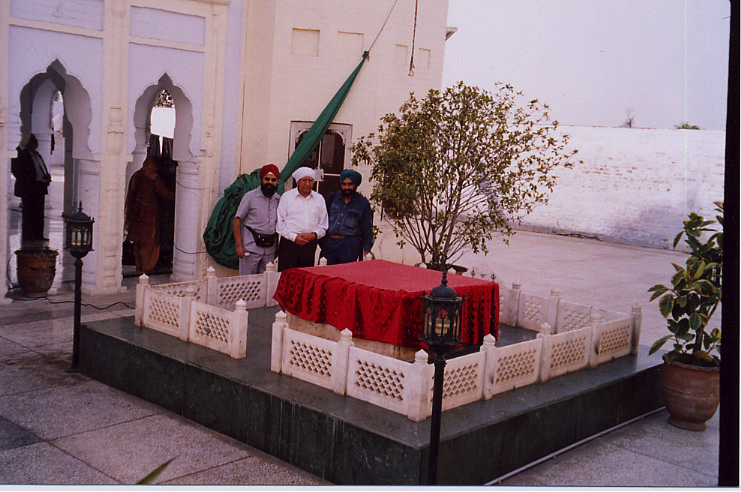 Sikh journalist Parminder Singh Soch, Dr. Harbans Lal and Dr. Kuldip Singh Hanjan at Guru Nanak mausoleum at Kartarpur.
Sikh journalist Parminder Singh Soch, Dr. Harbans Lal and Dr. Kuldip Singh Hanjan at Guru Nanak mausoleum at Kartarpur.
Nanakana Sahib Foundation Anniversary
Back in Lahore, we celebrated the 30th anniversary of the Sri Nanakana Sahib Foundation. This organization was set up first in New York in 1972 and then in 1975 in Pakistan under the leadership of Sardar Ganga Singh of Washington DC to pursue the matter of access to Sikhs’ holy places in Pakistan.
As a result of enhanced understanding, restrictions on Sikh pilgrims were all lifted except where bilateral agreements between India and Pakistan placed limits. The Pakistan Sikh Gurdwara Parbandhak (Management) Committee became law of the land on August 25, 2004. Now, the major historical shrines are continuously repaired, maintained and kept open to public. In my opening I recounted the story of Sikhs who were rehabilitated in the Punjab Province of Pakistan. It may be noted that there was no Sikh families living in Pakistan after its creation in 1947. Only many years later, when the Sikh community was reassured of their safety and freedom of movement, did a community re-establish itself.
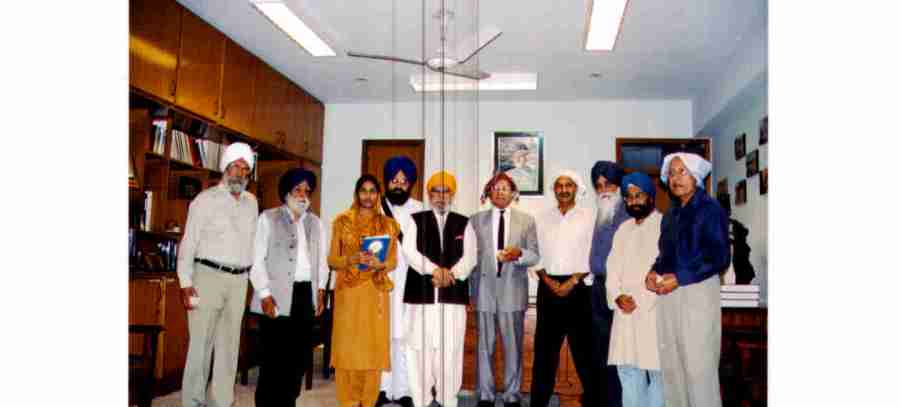
Executive Committee meeting of the Nanaka Sahib Foundation at Lahore Office of the Foundation, 2006. Among those present were Col. Choudhary Hamid Ali President, Sardar Dhillon Chairman, Bhai Harbans Lal Executive Vice President, Sardar Harbhajan Singh World Bank (retd), Sardar Kesar Singh Dhaliwal of Germany, and others during lunch break.
Reception By The Fakir Family Of Lahore
While in Lahore, we were given a reception dinner by the family of Faquir Azizul Din’s descendants at their home in Lahore. The Faqir had served as the Prime Minister of Maharaja Ranjit Singh. The famous Fakir Khana inside Bhati Gate in Lahore hosts the family’s collection of books, documents and other memorials. Several dignitaries of Lahore were also invited for the evening of poetry and storytelling by the family. At the end, a sword of honor was presented to me, to Sardar Ganga Singh, Prof. Darshan Singh, and some other dignitaries in recognition of services to the society and Sikh causes. We, in turn honored the Fakir family for their services to the Sikh Nation.
I was humbled by the invitation as I cannot think of another Muslim family who has held such a long and continuous association with the Sikhs as the Fakir family of Lahore. For more than two hundred years, the family continued to maintain loving contact between them and their Sikh friends despite changes in the political configurations within the subcontinent.
The family ancestors developed respect for Sikhs when Syed Ghulam Muhyuddin served under Zakaria Khan, then Governor of Lahore. Muhyuddin’s three sons – Azizuddin, Imamuddin and Nuruddin served in the court of Maharaja Ranjit Singh from the earliest years of his reign until his death in 1839. Faqir Azizuddin served Maharaj as his physician and his Prime Minister.
Succeeding generations of the Fakir family have continually nurtured their connection with Sikhs. In 1965, Col. Fakir Waheeduddin published The Real Ranjit Singh. In 1979 his son Fakir Aijazuddin published volumes of Pahari Paintings and Sikh Portraits in the Lahore Museum (1977) and Sikh Portraits by European Artists (1979), a biographical study of oil paintings in the Princess Bamba collection, displayed in the same Lahore Fort that had been the backdrop of the first germinating contact between the great Maharaja and the scions of the Fakir family.
The Dyal Singh Research & Cultural Forum
Before returning home, some of us spent a day with Harvard educated Director of Dyal Singh Research and Cultural Forum, Dr. Zafar Cheema. After visiting the center’s facilities and a discussion of what we could do together, a proposal was drafted outlining to undertake shared responsibility by the Center and the friends of the center abroad in promotion of Sikh information service. The center will provide facilities to expand significantly the scholarly holdings in the library, particularly Sikh literature in Urdu. The Center will finish a small apartment facility to house the visiting scholars for research and other scholarly work. The Center will also publish a periodical to disseminate knowledge on Sikhism and Sikh activities in Pakistan.

The Center will also hold periodic conferences on Sikhism. On our part, we provided copies of the Guru Granth and other Sikh literature on electronic media as provided by Dr. Kulbir Singh Thind of USA. The library clerk was given brief training on how to search the CD for information. We also promised to take the message to the international Sikhs to seek resources in the shape of books, computer software and visiting research scholars toward populating the library in Lahore. In future, the plans will be considered to digitize archival material on Sikhism left in Pakistan. More recently, the Nanakana Foundation provided the Sikh scripture, the Guru Granth in Urdu on electronic media to the Center.
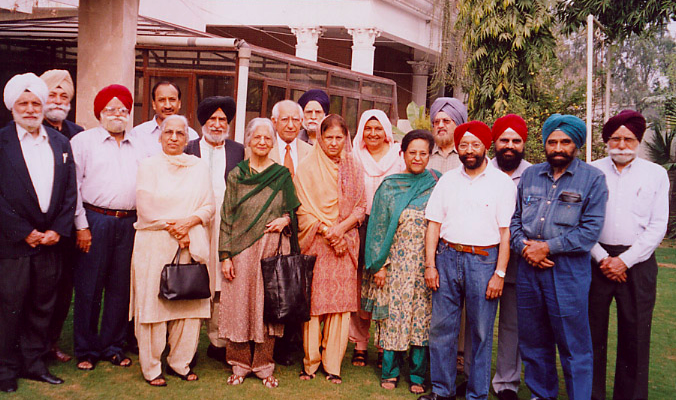
Dr. Lal. I enjoyed reading your article. Very interesting and informative. I wish you could have included more pictures in it, for example, City of Nanakana Sahab, Fakir family etc. Nonetheless, it was a good read. Thank you.
Mohammad Suleman.
Baba Nanak remains the leading spokesperson for peace and interfaith understanding. His teachings underline the basic facts of human psychology that we all wish to live in harmony and have respect for each other. His long travels abroad, often in hostile territories and climate, were made in search for finding common grounds and accommodations for varied political and social values. The end result of his search was Truth, Justice, Love and Service. These values became the sources of all fine Sikh traditions. He was a gifted voice of Punjab, born and raised in Nankana Sahib and Kartarpur. He enriched the mind and life of all those who came to hear him regardless of their religion and way of life. Considering his contributions to the world civilization, it would be very fitting for the government and people of Pakistan to declare Nankana Sahib as the World Cultural Heritage Place and in turn urge UNESCO to do likewise. It would be a tremendous boost to international relations and interfaith understanding and to follow up on the Lahore Conference dialogue.
I am very grateful to you, Dr. Lal for this excellent commentary and for a very informative essay on the Interfaith Engagement at the Lahore International Conference of Sikh and Muslim scholars. This Lahore Conference should be considered as a milestone in the path to the mutual understanding of faiths in South Asia. Such conferences should be held annually throughout the world to promote peace and harmony among all people and nations. I am eternally thankful to you for taking the lead on this important subject and enlightening us on the wonderful contributions of the Sikhs and the interfaith history. Thank you again.
Very Informative. Thanks for sharing.
Thank you for sharing this very interesting article & photos.
God Bless you to keep on with this good work
Gulraj Pritam Singh
President & Comptroller
JAKARTA SIKH GURUDWARA
I n d o n e s i a
Well Done. Dr.Harbans Lal
A very nice description of interfaith conference . It contains nice pictorial views of the area. You are providing tons of information for us and coming generations. We are thankful to you.
This is a very descriptive and fine commentary containing several important historical facts and noting the significant contributions of the Sikhs and their search for Truth that paves the road for the common good, irrespective of our individual religious adherences. The foundation of Sikh philosophy is based upon the principles of equality, tolerance and welfare of the community. Sikhism accommodates diversity and wishes well to the believers and non-believers alike. It does not threaten believers of other faiths unless threatened by others for what we believe in. We wish to live in harmony with our neighbours and seek freedom to search for Truth as professed by our founder Guru Nanak. Dr. Lal’s essay clearly illuminates the path of our search.
Dr Harbans Lal,
It is very interesting. write up.Thanks for sharing. Regards.
Sant S Virmani, PhD
Padmashri Awardee(2008)
Most Rev. Dr Harbans Lal Jee
Thanks for sharing the information of historical nature .
I feel deeply honored to offer 31 gun salute of divine love
& deep reverence .
I will share this vision with the Chair Person of Indo-Pak
Peace Club today. Wish you long life & health bliss being
a special beloved of BABA NANAK JEE…….WAHEGURU
Very enlightening.
I was not aware of many incidents/ facts mentioned in this most informative and valuable essay for PEACE and HARMONY in the World of Diversities in which we live. Guru Nanak toiled to uplift the HUMANITY, as such. He was not concerned with the Religion professed by his Sikh(literally meaning, follower/ disciple/ student).
This essay should be widely propagated for PEACE and HARMONY in the World. There is no room for Religious hatred. Both Sikhism and Islam promote Love for Alll!!!
Mutual Love is the Need. This can bring the countries together.